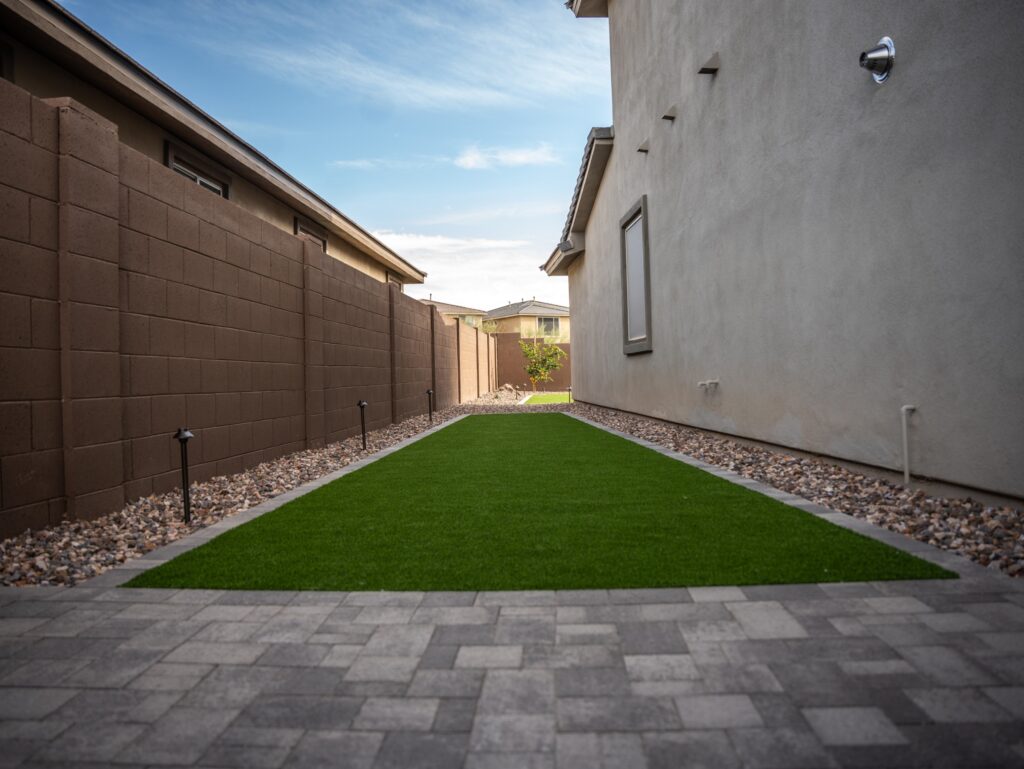So, you’re finally ready to ditch the lawnmower and say goodbye to yellow patches of grass. Smart move! But before you roll out your shiny new turf, there’s one crucial step you absolutely can’t skip—building a solid artificial turf base.
Here in Scottsdale, AZ, we deal with intense heat, rocky soil, and the occasional flash flood. That means skipping steps or winging it could lead to a lawn that buckles, pools water, or worse—has weeds popping through. Yikes.
Let’s break down exactly what goes under artificial turf (and why it matters) so you can enjoy a synthetic lawn that stays green, gorgeous, and low-maintenance for years to come.
Why the Artificial Turf Base is a Big Deal
Think of your artificial turf base as a foundation for a house. If you do not prep it correctly, nothing above it will work quite right. The base for artificial grass is what keeps your lawn level, allows for proper drainage, and provides support underfoot.
Without a proper sub-base, your fake grass can shift, sag, or become a breeding ground for bacteria and mold. Yeah, no thanks.
How to Build A Perfect Artificial Lawn Base
To build the best synthetic lawn base in sunny Scottsdale, here’s what you’ll need:
1. Excavation: Out with the Old
First things first—get rid of that old grass, topsoil, and anything organic. This means digging down about 3–4 inches (sometimes more, depending on your soil type). You don’t want any organic matter decomposing and causing dips or drainage issues later.
2. Weed Barrier: Don’t Skip It!
Install a high-quality weed barrier fabric. This is your first defense against rogue roots and weed growth. While Scottsdale doesn’t have the wettest climate, weeds are persistent little buggers.
3. Crushed Rock or Decomposed Granite Layer
Here’s where the magic happens. A crushed rocks or decomposed granite (DG) layer provides drainage and stability. You’ll want 2–3 inches of this material compacted in layers.
These artificial grass base materials are the gold standard in Arizona. It compacts well, drains fast, and doesn’t shift when dry or wet.
🛠 Pro Tip: Use angular crushed stone, not round gravel—it locks together better for stability.
4. Leveling and Compaction: Pack It Down

Using a plate compactor, pack down your base until it’s level and hard as a rock. (Well, not literally. But you get it.) This step is essential for a long-lasting artificial lawn base.
You may also want to add a thin layer of sand or “fines” to smooth it out before laying turf.
5. Drainage Layer (Optional but Recommended)
For areas prone to heavy rainfall or uneven soil composition, consider adding an artificial grass drainage layer. This allows water to escape faster and avoids soggy spots.
In Scottsdale, where hardpan clay soil is common, this extra layer can make a big difference during monsoon season.
What Happens If You Don’t Prep the Base Correctly?
Honestly? A whole mess. Here’s what can go wrong:
- Turf that feels spongy or shifts underfoot
- Pooling water or poor drainage
- Weeds popping through your synthetic lawn
- Shorter turf lifespan
Skipping or skimping on your turf base preparation is like painting over a cracked wall—you’re just asking for problems later.
Scottsdale-Specific Turf Tips 🌵
Our desert climate is no joke. Here are a few extra tips for those of us in the Valley:
- Check your soil type: Sandy soil may need extra compaction layers.
- Beware of sun exposure: Reflective windows can melt turf! Choose UV-resistant options.
- Consider elevation: Sloped yards may need extra drainage layers or edging.
Ready to Transform Your Lawn?
Whether you’re doing a DIY project or hiring professionals, knowing what goes under artificial turf is half the battle. A well-built artificial turf base is the secret to a flawless, long-lasting synthetic lawn—and nobody does it better than Rising Tide Landscapes in Scottsdale, AZ.
Get in touch with us today, and let’s build something beautiful from the ground up.
FAQs: Your Turf Base Questions Answered
1. Can you lay artificial turf directly on top of the soil?
Short answer: Nope. While it might be tempting to roll it out and call it a day, laying turf directly on soil can lead to poor drainage, weed growth, and an uneven surface. Scottsdale’s clay-heavy soil is especially problematic—it can expand, contract, and shift with heat and moisture. Always start with a compacted artificial grass base material like crushed granite or DG.
2. How deep should the base for artificial turf be?
For most residential installations, you’ll want to excavate at least 3–4 inches to make room for the turfs sub-base. In Scottsdale, where soil can be tough and rocky, sometimes going deeper helps with drainage. After you lay and compact your base material, you should have a solid, level surface ready to support your turf without any future settling.
Don’t Miss This!
Are you looking for some new and innovative ideas to transform your backyard? Don’t miss our next article: “Backyard Landscaping Ideas for Scottsdale Homes: Where Style Meets the Desert.“
